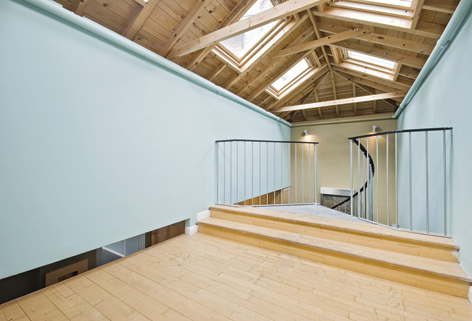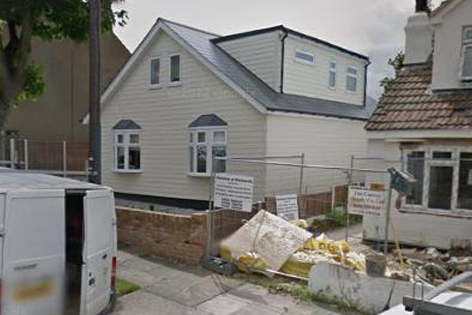Many people ask themselves the question, do I move and pay out stamp duty and moving expenses or do I stay put and extend or convert the loft of my existing property in order to add the extra space needed?
With the www.planningportal.gov.uk website, they are usually fairly au fait with the planning related considerations and what is possible to do under permitted development rights.
However, they often do not know where to start , in terms of seeing whether it is even potentially possible to do a loft conversion at their property.
We have put together this brief blog as a way of giving someone a starting point to assess practical viability prior to spending out money on drawings etc.
The two main areas to consider when deciding whether a loft conversion is potentially do-able at your property are :
- Headroom available to convert : I.e. the distance from the underside of the ridge to the upper face of the ceiling joists.
- Potential position for a staircase into the loft : I.e. is there an area available whereby the addition of a staircase would not constitute an unacceptable loss of space to the rooms.
Lets first focus on the first item : Headroom
A floor to ceiling height of 2.3 -2.4M mark in a finished conversion, is what we have found most people consider as “normal”
There is no building regulations height related standard for floor to ceiling height in a loft within the approved documents of the building regulations, however anything less than 2.3M might feel somewhat cramped.
The rule of thumb to establish whether headroom is sufficient or not :
To establish whether a reasonable headroom is possible, in order to get a rough idea , you should measure from the top of the ceiling joists to the underside of the ridge and take down the measurement.
Then by rule of thumb you should deduct from this measurement approximately 370mm or 0.37M (for dormer joist (Or collar member) thickness , plus insulation , plus an allowance for joist upgrade which is necessary for the habitable loads), Note the figure down
If Ceiling joists to ridge measurement minus 0.37 = 2.3M ( or close to it or more ), there is a chance you could convert your loft space for habitable purposes and have reasonable headroom.
i.e that the full height areas say to a rear dormer would feel like a normal room when you walk around inside the converted loft space.
If this end rule of thumb figure is less than 2,3M you would have to make a judgement call as to whether the degree of lowness to the ceiling would be acceptable to you.
Question : Can the thicknesses of insulation that intrude into the headroom available be reduced in some way?
Answer : Yes, sometimes we at M Brebner have overcome such issues by laying metal section joists in between the existing ceiling joists , together with cross solid noggins, which can calculate out successfully from a structural calculations perspective to take the habitable loads and does not significantly if at all decrease the joist to ridge level.
Sometimes this can work if say you had a top of ceiling joists to underside of ridge such, that in the traditional method of hanging larger floor joists between the existing ceiling joists from steels within the knee walls of the conversion would end up as being 2.2M after conversion (i.e. a bit low) , using this method it would being the eventual floor to ceiling height more close to the normally acceptable 2.3M, so there are some tricks up our sleeve to deal with borderline cases.
Another approach can sometimes be to lower the ceiling height if the first floor to ceiling height is relatively high and therefore can afford to lose a bit (sometimes the case in Victorian type houses with high ceilings).
However, the lowering of ceiling approach, involves affecting the existing ceilings so only really ought to be considered as a last resort.
9 times out of 10 , if the rule of thumb we have suggested here works out for your property , the existing ceilings normally do not need to be adversely affected in any way by the conversion.
Lets first focus on the Second item : Potential position for a staircase into the loft
With a staircase into a loft conversion, you ideally need to end up beneath the ridge of the roof, as this is a maximum headroom position which does not rob you of the usable full head height space you have created with a rear dormer for example.
Depending upon landing arrangements , it is sometimes possible to start the additional staircase off from the landing and run the new stairs above the existing staircase and still have sufficient headroom when walking up the original stairs to meet the building regulations headroom requirement of 2M
However , often it is necessary to start the stairs with kite winder steps in for example a front box room , in order to get up to a reasonable height before the new stairs goes over the top of the original stairs, thus losing a small amount of space from the existing room.
You really have to make a judgement call as to whether the space lost by the stairs is outweighed by the space gained in the loft.
Quite often if a box room is utilised to start the additional staircase, people utilise the remaining space as a small study type area, which is not so bad a loss if this is what it was really used for all along and a large bedroom with en-suite was achieved in the loft.
If two bedrooms could be gained in the loft , the small loss to the box room in this example might seem negligible.
Other things to bear in mind :
Just because from a planning perspective, your loft conversion comes within PD (permitted development rights) : YOU STILL NEED TO COMPLY WITH BUILDING REGULATIONS.
We have put this in caps, as often when we carry out building surveys for people buying houses, we come across loft conversions and ask the Vendor’s (The people selling the property), whether they have the necessary building regulations completion certificate for the conversion.
They often reply with , “No mate, we did it under PD so didn’t need to tell the council” or similar.
This is WRONG, as even if designed within PD rules, it still has to comply with the requirements of the building regulations, and the only way to demonstrate this in a resale scenario is to make a building regulations application and have the inspections at the key stages carried out and signed off by the building control officer (or licenced inspector) and obtain a building regulations completion certificate for your house records at the satisfactory end of the conversion.
If converting a house with a loft conversion, this makes the property 3 storeys and therefore triggers much more onerous building regulations requirements as regards PART B (Fire) of the building regulations.
If you already have an open plan arrangement on the ground floor, this can sometimes mean a sprinkler system may be required or the need to form a protected hallway to outside making the staircase no longer within the open plan space on the ground floor.
How M Brebner can help? :
We are experienced in designing loft conversions within PD rules or more elaborate designs subject to formal planning applications.
We are able to design up to and including building regulations stage and are good problem solvers when it comes to finding headroom etc.
We do have some recent examples of what different types of loft conversions cost after tendering out to a few good construction companies in a competitive manner, so call us and we ought to be able to give you a ball park figure.
Please give us a call if you are considering a loft conversion and we would be happy to talk to you about your requirements and produce a fee proposal for our services for you to consider.
Usually if you are happy enough with the price we offer in principal, we like to meet you face to face to discuss on a no obligations basis (Both ways) before agreeing to act on your behalf.
We hope this blog will be of some use to those of you considering a conversion and look forward to hearing from some of you soon.
Kindest regards
Mike Brebner
M Brebner MCIOB 01268 856154


